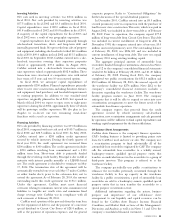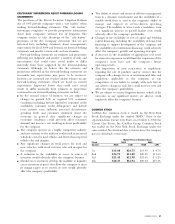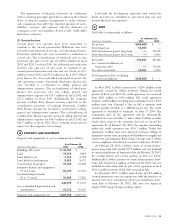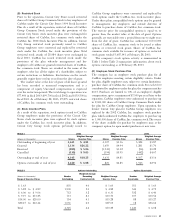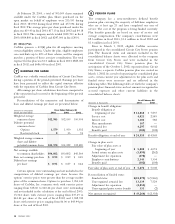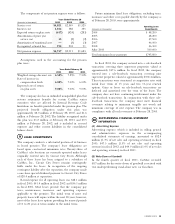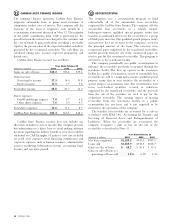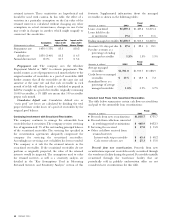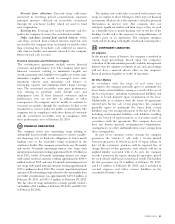CarMax 2003 Annual Report Download - page 36
Download and view the complete annual report
Please find page 36 of the 2003 CarMax annual report below. You can navigate through the pages in the report by either clicking on the pages listed below, or by using the keyword search tool below to find specific information within the annual report.
34 CARMAX 2003
(N) Revenue Recognition
The company recognizes revenue when the earnings
process is complete, generally either at the time of sale to a
customer or upon delivery to a customer. As part of its
customer service strategy, the company guarantees the
vehicles it sells with a five-day or 250-mile money-back
guarantee. If a customer returns the vehicle purchased
within the limits of the guarantee, the company will refund
the customer’s money. A reserve for returns is recorded
based on historical experience and trends.
The company sells extended warranties on behalf of
unrelated third parties. These warranties have terms of
coverage from 12 to 72 months. Because these third parties are
the primary obligors under these warranties, commission
revenue is recognized at the time of sale, net of a provision for
estimated customer returns of the warranties. The estimates
for returns are based on historical experience and trends.
(O) Advertising Expenses
All advertising costs are expensed as incurred.
(P) Net Earnings Per Share
Basic net earnings per share is computed by dividing net
earnings by the weighted average number of shares of
common stock outstanding. Diluted net earnings per share is
computed by dividing net earnings by the sum of the
weighted average number of shares of common stock
outstanding and dilutive potential common stock.
(Q) Stock-Based Compensation
The company accounts for its stock-based compensation
plans under the recognition and measurement principles of
Accounting Principles Board Opinion (“APB”) No. 25,
“Accounting for Stock Issued to Employees,” and related
interpretations. As such, compensation expense would be
recorded on the date of grant and amortized over the
period of service only if the current market value of the
underlying stock exceeded the exercise price. No stock-
based employee compensation cost is reflected in net
earnings, as options granted under those plans had an
exercise price equal to the market value of the underlying
common stock on the date of grant.
In December 2002, the Financial Accounting Standards
Board (“FASB”) issued SFAS No. 148 “Accounting for
Stock-Based Compensation–Transition and Disclosure–an
Amendment of SFAS No. 123.” The company adopted the
disclosure provisions of SFAS 148 in the fourth quarter of
fiscal 2003. The following table illustrates the effect on net
earnings per share as if the fair value method of accounting
had been applied to all outstanding stock awards in each
reported period as follows:
Years Ended February 28
(Amounts in thousands) 2003 2002 2001
Net earnings, as reported $94,802 $90,802 $45,564
Total stock-based compen-
sation expenses determined
under fair value based
method for all awards,
net of related tax effects 4,391 1,559 979
Pro forma net earnings $90,411 $89,243 $44,585
Earnings per share:
Basic, as reported $ 0.92 $ 0.89 $ 0.45
Basic, pro forma $ 0.88 $ 0.87 $ 0.44
Diluted, as reported $ 0.91 $ 0.87 $ 0.44
Diluted, pro forma $ 0.86 $ 0.86 $ 0.44
The pro forma effect on fiscal year 2003 may not be
representative of the pro forma effects on net earnings for
future years.
For the purpose of computing the pro forma amounts
indicated above, the fair value of each option on the date of
grant was estimated using the Black-Scholes option-pricing
model.The weighted average assumptions used in the model
are as follows:
Fiscal 2003 2002 2001
Expected dividend yield ———
Expected stock volatility 76% 79% 71%
Risk-free interest rates 4% 5% 7%
Expected lives (in years) 544
Using these assumptions in the Black-Scholes model, the
weighted average fair value of options granted was $17 per
share in fiscal 2003, $3 per share in fiscal 2002 and $1 per
share in fiscal 2001.
(R) Derivative Financial Instruments
In connection with securitization activities through the
warehouse facility, the company enters into interest rate
swap agreements to manage exposure to interest rates and to
more closely match funding costs to the use of funding.The
company recognizes the interest rate swaps as either assets or
liabilities on the consolidated balance sheets at fair value
with changes in fair value included in earnings.
(S) Risks and Uncertainties
CarMax retails used and new cars.The diversity of CarMax’s
customers and suppliers reduces the risk that a severe impact
will occur in the near term as a result of changes in its
customer base, competition or sources of supply. However,
because of CarMax’s limited overall size, management
cannot assure that unanticipated events will not have a
negative impact on the company.



